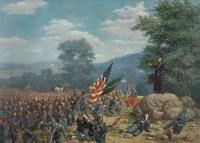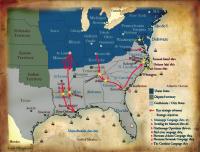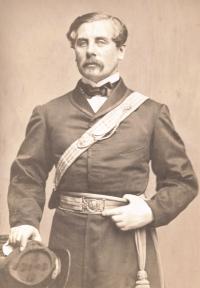‘Where the murderin’ cannons roar . . .’: The American Civil War
Published in 18th–19th - Century History, Features, Issue 5 (Sept/Oct 2012), Volume 20
Absolution Under Fire by Paul Wood—chaplain Fr William Corby administering absolution to Union soldiers of the Irish Brigade after the Battle of Gettysburg, July 1863. (Snite Museum of Art)
The American Civil War was the first great conflict of the industrial age and developed many of the technological, economic and political features that were to transform later warfare. Superior military leadership enabled the weaker Confederacy to keep the Union forces at bay for four years, but ultimately Napoleon’s aphorism that ‘God is on the side of the heavier battalions’ was vindicated. This was also a conflict of rival cultures, and even nationalisms, and was enflamed by the issue of slavery, which had been a feature of American society since colonial times.
The ‘peculiar institution’
The first African slaves were landed in Virginia in 1619 and by the end of the seventeenth century the ‘peculiar institution’ had become an accepted system of servitude, except in the North, where it disappeared in the decades after independence. Slavery had been an embarrassment to the Founding Fathers, who, although mostly slave-owners themselves, declared their country’s independence with the assertion that ‘all men are created equal’. The 1787 constitution reflected this discomfiture. Nowhere did the actual words ‘slave’ or ‘slavery’ appear. Its authors preferred circumlocutions like persons ‘held to service or labour’. Some, particularly Washington and Jefferson, believed that slavery would decline and eventually disappear.Yet it did not decline. The invention in the 1790s of the cotton-gin—which separated the cotton lint from its seeds—spread the cultivation of the crop across the South during the early nineteenth century, and slavery became a steadily more important component of the region’s economy, accentuating an existing economic cleavage. The North had become a centre for manufacturing and commerce comparatively early, while the South remained wedded to the cultivation of cotton and other tropical crops. Northern attempts to secure national banking legislation and protective tariffs for its industry were met with suspicion by Southerners wishing to protect their own interests. The first indication of growing tension arose with the Compromise of 1820, which sought to maintain a congressional balance by admitting Missouri to the Union as a slave state and Maine as a free one. It also prohibited slavery in areas north of the line 37 degrees 30 inches in land acquired through the Louisiana Purchase of 1802.
 The break-up
The break-up
Southerners protested at this limitation of slave territory, but without satisfaction. In 1831 two significant events occurred. One was the Nat Turner rising in Virginia, the first serious slave insurrection since colonial times, which stirred up fear in the South of the violence that would accompany change and led to a tightening of the system. The second was the publication in Boston of William Lloyd Garrison’s abolitionist journal The Liberator. In the years that followed, slavery came under increased attack by Northern liberals. Southerners grew more obdurate, and John C. Calhoun of South Carolina, an advocate of ‘states’ rights’, described slavery as ‘a positive good’ on the floor of the US senate in 1837.In the 1850s Northern and Southern opinion stiffened further and the Union’s future was questioned. Harriet Beecher Stowe’s novel Uncle Tom’s cabin (1852) convinced many Northerners of the intrinsic evils of slavery. In 1859 John Brown’s raid on an arsenal in Harper’s Ferry, Virginia, rekindled fears of a slave uprising. By 1860 it was clear that the sole institution binding the country was the nationally organised Democratic Party. But this now split on the vital issue (April 1860) and it was soon apparent that the new, largely Northern, Republican Party would win the coming presidential election. Its candidate, Abraham Lincoln, called not only for an end to the expansion of slavery into new territories but also for higher tariffs, banking legislation and increased federal oversight, policies the South had long resisted. Lincoln’s election therefore seemed to the Southern states an assertion of impending Northern dominance. Rather than accept this, they opted to quit the Union.Following Lincoln’s election, a state convention in South Carolina voted to secede on 20 December 1860. By his inauguration on 4 March 1861 South Carolina had been joined by Georgia, Alabama, Mississippi, Louisiana, Florida and Texas, who constituted themselves as the Confederated States of America and elected Jefferson Davis, a former US senator, as their president. They established their own legislature, issued their own currency, raised their own taxes and flew their own flag. In May 1861 they transferred their capital from Montgomery, Alabama, to Richmond, Virginia.
The years of blood
When the newly formed Confederate army bombarded Fort Sumter, Charleston, SC—a coastal fortification occupied by the Union army—in April 1861, Lincoln issued a call for 75,000 volunteers to put down the rebellion. This provoked four border states—Virginia, North Carolina, Tennessee and Arkansas—to join the Confederacy, thus depriving the Union of key military personnel, notably Robert E. Lee, Thomas (later ‘Stonewall’) Jackson, Braxton Bragg and Pierre Beauregard. Most Americans thought the resulting conflict would be brief. They could not have been more mistaken. No one realised how prolonged the war would be or how many Americans would die. The carnage—over 630,000 dead—would cause seasoned observers to wince. Furthermore, the entire ante-bellum Southern way of life would be blown away.Although the Union had the greater economic and military strength, these advantages were not immediately apparent. Indeed, the first two years of hostilities were bleak for the Union. In July 1861 the Confederates inflicted a humiliating defeat at Bull Run, Virginia. The following year, Union General George B. McClellan landed troops on the Virginian coast in a lacklustre effort to capture the Confederate capital, Richmond. Pinned down by Lee and harassed by the cavalry of ‘Jeb’ Stuart, he was forced to retreat.The Union’s predicament was clear: while the South had only to defend its territory to win, Union generals had to take the offensive if they were to overcome the rebels. McClellan and other commanders appeared hamstrung and incapable of action. Until 1863 Southern generalship was markedly superior, particularly in the vital eastern theatre, where Lee and Jackson showed remarkable flair. On both sides, however, casualty figures mounted relentlessly. Set-piece battles at Shiloh, Antietham and Fredericksburg were a grim testimony to the futility of it all and pointed to stalemate.The only Union successes during 1861–2 were naval ones. Federal gunboats played an important role in Ulysses S. Grant’s seizure of Forts Donaldson and Henry in western Tennessee, and Commodore David Farragut captured New Orleans. The strangest naval engagement, however, was the drawn battle between two ironclad warships, the SS Monitor and the CSS Merrimac, at Hampton Roads, Virginia. This famous duel heralded the demise of wooden fleets, but it was only the Union, with its greater industrial strength, that built a significant number of ironclads. Their presence ensured that the blockade of Southern ports remained effective.
The race question
With the Union armies stalled, Lincoln found himself under attack for his tentative approach, particularly his reluctance to alienate the loyal slave states—Delaware, Kentucky, Maryland and Missouri—by tackling the race question. Without slavery, it was argued, the Confederate military effort could not be sustained. On 22 September 1862 he gave way and issued the Emancipation Proclamation, which declared all slaves beyond Union lines to be free.Lincoln had good reason to be wary. Many Northerners were contemptuous of blacks and rejected the notion that abolition was a war aim. The pressing need to break the stalemate, however, resulted not only in the proclamation but also in the enlistment of black troops in the Union army. Segregated in separate ‘coloured’ regiments and officered by whites, these Americans from 1863 played a notable role in the Union’s war effort.July 1863 brought a turning point when the Union won two crucial victories. The first came at the road junction of Gettysburg, Pennsylvania. With time running out, the South determined that a crushing victory might prompt foreign recognition and Robert E. Lee launched an audacious invasion of the North. He stumbled across the Army of the Potomac near the junction. After a vainglorious assault—known famously as ‘Picket’s charge’—on the Union centre, Lee was forced to retreat. The next day—4 July—brought the surrender of Vicksburg, a Confederate stronghold whose guns commanded the Mississippi River, to the besieging troops of Ulysses S. Grant. These defeats gnawed at the Confederacy’s vitals, ended hope of diplomatic recognition and presaged the paralysing blows to come.

Brigadier-General Thomas Francis Meagher, born in Waterford in 1823. In a speech to the Repeal Association in 1846 the Young Irelander praised the sword as a sacred weapon and was dubbed by Thackeray ‘Meagher of the Sword’. Arrested after the 1848 rising, his death sentence was commuted to transportation to Van Dieman’s Land. Within a few years he escaped and arrived in New York in 1852, where he became a newspaper proprietor and lawyer. As a staunch Democrat he supported the party’s policy of non-interference with slavery, but quickly swung behind the Union. Much of his energy was spent in recruiting the Irish Brigade and he was commissioned brigadier-general in February 1862. Prominent—and often in command—during the brigade’s fiercest actions, he was on the field at Malvern Hill, Antietham and Fredricksburg. After the war he was appointed temporary governor of the Montana territory. He drowned in mysterious circumstances in the Missouri River in 1867—his supporters asserted that he had been murdered.
Decline and fall
Limited manpower and lean resources took their toll on the Confederacy. Its troops were hungry, poorly clad and low on ordnance; its economy was ravaged by inflation and choked of supplies; its communications faltered and its politicians bickered. During 1864 Union armies penetrated deep into its territory. One thrust, led by Grant, pushed south into Virginia but was met with stout resistance at the Wilderness. Another, commanded by General William T. Sherman, drove south-east into Georgia. In September his troops took Atlanta. This development meant that a compromise peace was now unattainable, for it boosted Lincoln and guaranteed his re-election.The Confederates stubbornly hung on. With the fall of Atlanta, Sherman cut himself loose from his lines and set off towards Savannah. His ‘march to the sea’ left swathes of destruction across Georgia. The rampage was not the running amuck of soldiery but a deliberate operation ordered by Sherman and rigidly executed. From Savannah, he wheeled north into the Carolinas to link up with Grant in Virginia. The war ended before he arrived. Richmond was evacuated on 2 April 1865 and Jefferson Davis fled for his life. He was subsequently captured and imprisoned, but survived to write his memoirs.
Denouement
The end had been inevitable since Gettysburg. In the final months the war became a series of stunts by desperate men to escape the net closing around them. Lee cunningly tried to elude Grant but it was no use. He threw in the towel on 9 April and surrendered at Appomattox, Virginia. The scene was an odd one: Lee, the defeated, arrived in splendid dress uniform with sash and jewelled sword; Grant, the victor, wore a private’s jacket and smudged trousers tucked into muddy boots. They chatted courteously on their pre-war days at West Point and Grant read the surrender terms. The war was over, and Union followers everywhere cheered with delight. In New York and Boston people danced in the streets, singing John Brown’s body and other favourites.Five days later—14 April—Lincoln welcomed Grant to the White House. That evening he went to Ford’s Theatre, a few blocks away, to see a comedy, Our American cousin. The house was full as he and his wife settled into their box. They laughed heartily at the farce, but towards the end a man stole up behind Lincoln and discharged a pistol into his head. The bullet lodged behind the right eye and he slumped forward, unconscious. Those who heard the shot thought it was part of the play, until a man jumped down on the stage shouting ‘Sic semper tyrannis!’ (‘So it is always with tyrants’). As a curl of smoke drifted upwards, Mrs Lincoln screamed, ‘They have shot the President!’

The surrender of General Robert E. Lee at Appomattox, Virginia, 9 April 1865, as depicted by Irish eyewitness Andrew J. Byrne. (Memoir of Andrew J. Byrne)
The assassin was an insane actor named John Wilkes Booth, who escaped but was found two weeks later and shot. Lincoln was taken to a house across the street but died the next morning. A cabinet colleague pronounced his epitaph: ‘Now he belongs to the ages’. The killing deprived America of Lincoln’s shrewd and honest leadership when it was most needed. He had long reflected on the problems of reconciliation and of doing justice to the freed slaves. It would take another century before the South would fully rejoin the Union. The legacy of the war is still debated. What is not in doubt is its rueful connection with the vicious racism that has marred modern America. HI
Kevin Haddick Flynn is the author of Orangeism—the making of a tradition (1999) and Sarsfield and the Jacobites (2003).
Further reading
D. Donald, Why the North won the Civil War (Baton Rouge, 1960).B.J. Lossing, Field book on the Civil War (3 vols, Baltimore, 1979).J. McPherson, Battle cry of freedom (Oxford, 1988).
















